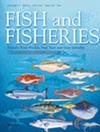Spatial Distribution of Numerical Density of Pelagic Juveniles (0‐Group) of Broadcast Spawning Fish Stocks Follows a Common Statistical Pattern
IF 6.1
1区 农林科学
Q1 FISHERIES
引用次数: 0
Abstract
Statistical distributions of spatial abundance data of animal populations can be informative about underlying processes and mechanisms that govern the spatial distributions. Here, we examine a large data set from annual 0‐group fish surveys in the Barents Sea (1980–2017) collected with standardised trawl sampling from a regular grid with 30–35 nautical miles between stations. The primary data are expressed as swept‐area density of 0‐group individuals for six fish species. The annual data series are highly right‐skewed with a tail of high values on a linear scale but are close to lognormal with log‐transformed data. The 0‐group density spans typically 4–5 orders of magnitude for the annual series. When stations are ranked in order from highest to lowest density, they show a common pattern for the six species across the annual series. With log‐transformed data, this pattern is a near log‐linear relationship but with an upswing in the high‐density end revealing higher variability for the top stations. The cumulative version with linear‐scale data is approximated by a simple asymptotic model. Between 14 and 42% of the total number of sampled individuals of a year‐class were on average contained in the highest ranked station for the six species, while 50% of the sampled individuals were found in the first 2–7 highest ranked stations. The common and consistent pattern of the ranked distributions is interpreted to reflect the opposing forces of physical dispersion, on the one hand and aggregation by swimming and schooling, on the other.广播产卵鱼类远洋幼鱼(0‐组)数量密度的空间分布遵循一个共同的统计模式
动物种群空间丰度数据的统计分布可以提供关于控制空间分布的潜在过程和机制的信息。在这里,我们研究了巴伦支海每年0组鱼类调查(1980-2017)的大量数据集,这些数据集是通过标准化拖网采样从站点之间30-35海里的规则网格中收集的。原始数据表示为6种鱼类0群个体的扫面积密度。年度数据序列在线性尺度上具有高度右偏和高值尾部,但在对数变换数据上接近对数正态。在年度序列中,0 -群密度通常跨越4-5个数量级。当站点按照从高到低的密度排序时,它们在全年序列中显示出六种物种的共同模式。对于对数转换数据,这种模式是一种接近对数线性的关系,但在高密度端有上升趋势,表明顶部站的变异性更高。具有线性尺度数据的累积版本由一个简单的渐近模型近似。在6个物种中,排名最高的站点平均含有14 ~ 42%的年级样本,而排名前2 ~ 7个站点平均含有50%的年级样本。排名分布的共同和一致的模式被解释为反映了物理分散(一方面)和游泳和学校教育的聚集(另一方面)的相反力量。
本文章由计算机程序翻译,如有差异,请以英文原文为准。
求助全文
约1分钟内获得全文
求助全文
来源期刊

Fish and Fisheries
农林科学-渔业
CiteScore
12.80
自引率
6.00%
发文量
83
期刊介绍:
Fish and Fisheries adopts a broad, interdisciplinary approach to the subject of fish biology and fisheries. It draws contributions in the form of major synoptic papers and syntheses or meta-analyses that lay out new approaches, re-examine existing findings, methods or theory, and discuss papers and commentaries from diverse areas. Focal areas include fish palaeontology, molecular biology and ecology, genetics, biochemistry, physiology, ecology, behaviour, evolutionary studies, conservation, assessment, population dynamics, mathematical modelling, ecosystem analysis and the social, economic and policy aspects of fisheries where they are grounded in a scientific approach. A paper in Fish and Fisheries must draw upon all key elements of the existing literature on a topic, normally have a broad geographic and/or taxonomic scope, and provide general points which make it compelling to a wide range of readers whatever their geographical location. So, in short, we aim to publish articles that make syntheses of old or synoptic, long-term or spatially widespread data, introduce or consolidate fresh concepts or theory, or, in the Ghoti section, briefly justify preliminary, new synoptic ideas. Please note that authors of submissions not meeting this mandate will be directed to the appropriate primary literature.
 求助内容:
求助内容: 应助结果提醒方式:
应助结果提醒方式:


